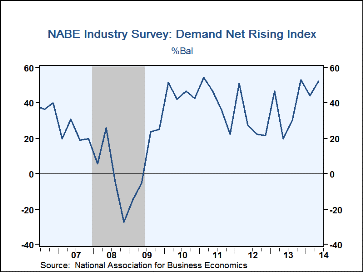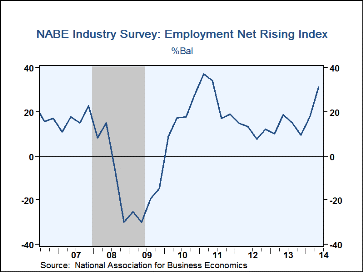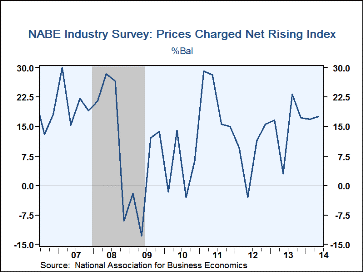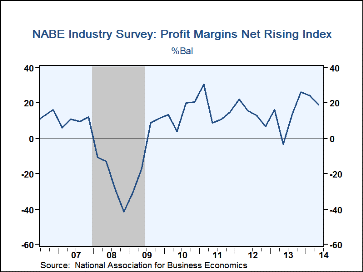 Global| Jul 21 2014
Global| Jul 21 2014Business Economist Survey Indicates Widespread Improvement in Business Conditions
by:Tom Moeller
|in:Economy in Brief
Summary
The National Association for Business Economics regularly surveys its members regarding industry conditions, covering a wide range of topics. The latest survey indicated improvement in most categories or a return to conditions in [...]
The National Association for Business Economics regularly surveys its members regarding industry conditions, covering a wide range of topics. The latest survey indicated improvement in most categories or a return to conditions in place before the last recession.
The unit demand index indicated great strengthening to nearly the firmest level since the mid-1990s. The percentage reporting rising activity firmed considerably to 57.1%, and those indicating falling activity dropped sharply to 4.8%, to nearly the lowest in the series. Labor market conditions also firmed. The employment index gained sharply this quarter as the reading of rising conditions improved sharply to 36.1% and the falling conditions index fell to 4.8%, also to nearly the lowest ever. Capital spending intentions strengthened to almost a ten-year high as the rising index rose sharply and falling plans fell to a minimal 5.2%. Finally, the wages & salaries index showed great improvement in workers' earnings. The net rising index rose to roughly the 2006 high as the percentage with increases firmed significantly to 43.0% but those with decreases reached the record low of zero.
Other component series firmed as well, but a little less so than those above. The materials cost index remained unchanged at 27.4%, roughly the middle of the range during the last 20 years. The reading came as 29.0% reported higher costs against 2% which reported them lower. More than two-thirds of respondents reported materials costs as unchanged. The prices charged series gained slightly this quarter, but it also remained near the middle of the long-term trend. Though 25.3% reported rising prices charged, two-thirds reported them unchanged. Finally, the profit margins index dipped this month as a greatly lessened 26.6% of respondents reported rising margins but nearly a record low 7.6% indicated that they fell.
The NABE Net Rising Indexes below are the percentage of respondents reporting rising conditions less the percentage reporting them falling. The figures are contained in Haver's SURVEYS database.
| NABE Industry Survey (Net Rising Index) | Q2 | Q1 | 2013 | 2012 | 2011 |
|---|---|---|---|---|---|
| Unit Demand | 52.4 | 44.4 | 37.4 | 30.6 | 40.0 |
| Employment | 31.3 | 18.1 | 13.3 | 12.0 | 26.9 |
| Capital Spending | 35.1 | 32.3 | 19.6 | 16.1 | 32.5 |
| Materials Costs | 27.4 | 27.3 | 17.9 | 17.6 | 42.4 |
| Prices Charged | 17.7 | 16.9 | 15.1 | 8.4 | 22.0 |
| Profit Margins | 19.0 | 24.2 | 13.2 | 14.4 | 16.3 |
| Wages & Salaries | 43.0 | 32.4 | 17.6 | 24.3 | 24.3 |
Tom Moeller
AuthorMore in Author Profile »Prior to joining Haver Analytics in 2000, Mr. Moeller worked as the Economist at Chancellor Capital Management from 1985 to 1999. There, he developed comprehensive economic forecasts and interpreted economic data for equity and fixed income portfolio managers. Also at Chancellor, Mr. Moeller worked as an equity analyst and was responsible for researching and rating companies in the economically sensitive automobile and housing industries for investment in Chancellor’s equity portfolio. Prior to joining Chancellor, Mr. Moeller was an Economist at Citibank from 1979 to 1984. He also analyzed pricing behavior in the metals industry for the Council on Wage and Price Stability in Washington, D.C. In 1999, Mr. Moeller received the award for most accurate forecast from the Forecasters' Club of New York. From 1990 to 1992 he was President of the New York Association for Business Economists. Mr. Moeller earned an M.B.A. in Finance from Fordham University, where he graduated in 1987. He holds a Bachelor of Arts in Economics from George Washington University.










